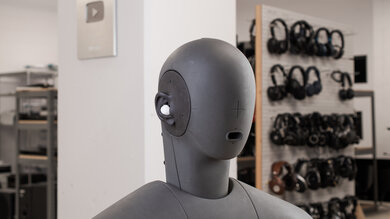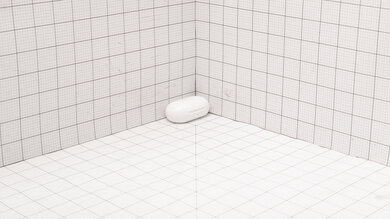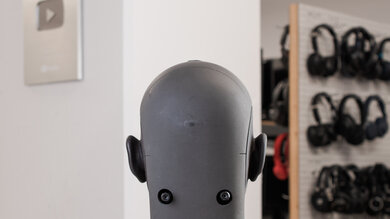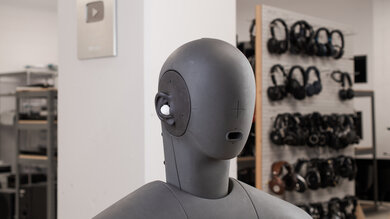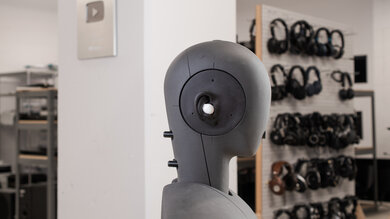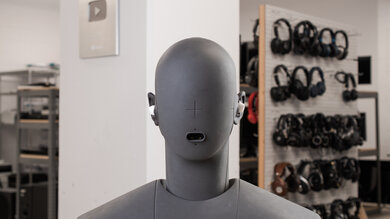The Samsung Galaxy Buds+ Truly Wireless are an improved version of the older Samsung Galaxy Buds Truly Wireless. They look and feel identical and have the same sleek, compact design. Their out-of-the-box sound profile is very well-balanced, and their companion app is available for iOS as well as Android, unlike the older model's Android-only app. They have a much longer continuous battery life, with over 13 hours of playback time from a single charge, which is very impressive for a pair of truly wireless headphones. Unfortunately, their touch-sensitive controls can be a little finicky. Still, if you're looking for a versatile pair of truly wireless in-ears, these are a good choice.
Our Verdict
The Samsung Galaxy Buds+ are good for neutral sound. Their out-of-the-box sound profile is extremely well-balanced and neutral-sounding, so they should suit different genres. Unfortunately, their passive soundstage is bad, meaning their sound seems to come from inside your head instead of the room around you, but this is normal for closed-back in-ear headphones.
- Well-balanced sound profile is well-suited for a wide variety of content and genres.
- Companion app with EQ presets.
- Alright microphone noise handling capability.
- Closed-off soundstage.
The Samsung Galaxy Buds+ are good headphones for commuting. While they don't block out the low rumble of plane or bus engines, they're quite comfortable, so you should be able to wear them during long trips without feeling any fatigue. Their 13.5-hour battery life is also quite impressive, so you shouldn't have to charge them during a long travel day.
- Impressive 13.5-hour battery life.
- Compact, lightweight construction.
- Sturdy build quality.
- Alright microphone noise handling capability.
- Hard-to-use control scheme.
The Samsung Galaxy Buds+ are great headphones for sports. They're quite comfortable and feel very stable in the ear, even during more strenuous workouts. They come with different sizes of stability fins and silicone tips to help you find a good, secure fit. They're also rated IPX2 for water resistance, though this isn't something we currently test for.
- Comfortable and stable design.
- Compact, lightweight construction.
- Sturdy build quality.
- Alright microphone noise handling capability.
- Hard-to-use control scheme.
The Samsung Galaxy Buds+ are satisfactory for office use. They're lightweight, comfortable, and have a battery life of roughly 13.5 hours, so you should be able to wear them all day without getting uncomfortable or needing to recharge them. They leak very little audio, and while they can't really block out sounds like passing buses or plane engines, they're very effective when it comes to blocking out background conversations and other higher-pitched noise.
- Impressive 13.5-hour battery life.
- Comfortable and stable design.
- Alright microphone noise handling capability.
- Only one additional charge from charging case.
- No multi-device pairing capability.
- High audio latency on PC.
The Samsung Galaxy Buds+ aren't recommended for wireless gaming. While you can connect them to a Bluetooth-enabled PC, the latency is likely to be too high for gaming. They also aren't compatible with Xbox One or PS4 consoles.
The Samsung Galaxy Buds Plus are Bluetooth-only headphones that can't be used on a wired connection.
The Samsung Galaxy Buds Plus are alright for making phone calls. The microphone has a mediocre recording quality, so your voice should sound understandable but may be muffled and lack detail. It does a decent job of isolating your voice from ambient noise, so it should be fairly audible even in loud environments. They aren't very good at blocking out rumbling sounds like engines, unfortunately, but do an excellent job with higher-pitched noise like background chatter.
- Alright microphone noise handling capability.
- Mediocre microphone recording quality.
Changelog
- Updated Jun 12, 2023: We've updated our Controls text to make it clearer that the volume controls aren't available in their default setup.
- Updated Jun 29, 2021: Converted to Test Bench 1.5.
- Updated Mar 03, 2021: Updated review for accuracy and clarity.
- Updated Nov 10, 2020: Updated review for accuracy and clarity.
Check Price
Differences Between Sizes And Variants
There are five color variants of the Samsung Galaxy Buds+: 'Black', 'White', 'Red', 'Cloud Blue', and 'Aura Blue'. We tested the 'White' variant but expect the other color variants to perform similarly overall.
If someone comes across a different version of the Samsung Galaxy Buds+, let us know in the discussions below so that we can update our review.
Popular Headphones Comparisons
The Samsung Galaxy Buds+ are a decent improvement over 2019's Samsung Galaxy Buds Truly Wireless. They're almost identical but with much-improved battery life and an iOS-compatible companion app. However, they lack an ANC feature, unlike the Samsung Galaxy Buds Live and the Samsung Galaxy Buds Pro.
Check out our recommendations for the best truly wireless earbuds, the best wireless earbuds, and the best noise cancelling earbuds and in-ears.
The Samsung Galaxy Buds+ are better headphones than the Samsung Galaxy Buds Pro. The Buds+ have a more stable in-ear fit, a better-balanced sound profile, and longer-lasting continuous battery life with a standby mode to help conserve battery life when not in use. However, some users may prefer the Pro's ANC feature, which can help cut down some ambient noise around you.
The Samsung Galaxy Buds+ and the Apple AirPods Pro are both very decent pairs of truly wireless headphones. The Apple have slightly easier-to-use controls, a more premium-feeling case, much better isolation performances thanks to their ANC feature, and a slightly longer overall battery life, and they are easier to pair to Apple devices. On the other hand, the Samsung have a more accurate out-of-the-box sound profile, a significantly longer single-charge battery life, and a better app for both iOS and Android that offers EQ presets, and they are easier to pair with compatible Samsung devices.
The Samsung Galaxy Buds+ are a decent improvement over the previous generation Samsung Galaxy Buds. Both truly wireless headphones are very small, lightweight, and comfortable, and they look identical. They both have an extremely well-balanced sound profile out of the box, and access to five different EQ presets. The Buds+ have a much longer 13.5-hour battery life, which is quite impressive for a pair of truly wireless headphones, and you still get an additional full charge from the case. iPhone users can also access the customization options now, as Samsung has made a version of the companion app available for iOS devices, which is great.
The Samsung Galaxy Buds+ are better than the Sony WF-C500 Truly Wireless for most purposes. The Samsung have a much more comfortable, stable fit and a more neutral default sound profile that some may prefer. They also have lower latency with iOS and Android devices and a mic with a much better noise handling performance. On the other hand, the Sony have a much better passive noise isolation performance and easier-to-use controls.
Test Results

These headphones look identical to the older Samsung Galaxy Buds Truly Wireless, with a far more conventional in-ear design than the newer Samsung Galaxy Buds Live Truly Wireless. They're quite small and don't protrude out of the ears. The earbuds have a glossy plastic finish and look quite premium. Some color variants, including the as-tested 'White' version, have an iridescent finish on their touch-sensitive surface.
These in-ears are quite comfortable. They shouldn't put pressure on your inner ear and don't enter your ear canal too deeply. They're also very lightweight, so you should be able to wear them for extended periods without experiencing any discomfort. If you want an even more comfortable pair of in-ears with tips that you can mold to fit the shape of your ear, check out the Ultimate Ears FITS Truly Wireless.
The Samsung Galaxy Buds Plus have an easy-to-use control scheme that provides some audio feedback when in use. Their touch-sensitive surface means that you don't have to push the earbuds further into your ear when you use it, which is nice, but unfortunately, this design makes it easy to register a command accidentally. It's also difficult to use the controls while wearing gloves. In addition, the buds don't have volume control by default; you have to add them via the companion app. On the upside, you can customize the long press to register different controls, including triggering volume adjustment, which is great. You can also set the edge of the earbuds' touch sensor to adjust your volume up/down with a double-tap.
The charging case for these headphones is great. Its hinge stays open at any angle, which feels secure. It feels quite premium and is made from solid and high-grade plastic. It also supports Qi-enabled wireless charging, which is nice.
These in-ears feel quite well-made overall. Both the case and the earbuds themselves are made from dense plastic and feel like they should easily withstand a few accidental drops or bumps. They're rated IPX2 for basic water resistance, which is lower than the Samsung Galaxy Buds Pro Truly Wireless' IPX7 rating. However, we don't currently test for this.
The Samsung Galaxy Buds+' out-of-the-box sound profile is well-balanced. Its bass response delivers adequate thump and rumble, while vocals and lead instruments are present and clear. Sibilants are also detailed without being overly piercing or harsh. If that's not to your liking, their companion app features six different EQ presets to better suit your preferences.
Like most in-ear headphones, the frequency response consistency is outstanding. Once you achieve a proper fit using the included tips, you should experience consistent bass and treble delivery every time you use them.
These headphones have incredible bass accuracy. Their bass range is very neutral, so the thump, punch, and boom of your music is present but not overwhelming. Fans of EDM and hip-hop who want a more bass-heavy, boomy sound can use the 'Bass Boost' EQ preset in the companion app, although we don't test it currently.
These headphones have fantastic mid-range accuracy. Vocals and instruments should sound present and clear. There's a small dip in the mid-mid range, which nudges vocals and instruments back slightly, but it shouldn't be noticeable for most people.
These headphones have excellent treble accuracy. Vocals and lead instruments should sound bright and detailed without being harsh. However, a small dip in the mid-treble range means sibilants, like cymbals or S and T sounds in speech, are somewhat dulled.
The Samsung Galaxy Buds Plus have excellent peaks and dips performance. Their entire frequency response is well-balanced, and while there are a few bumps in the treble range, they're minor, so vocals and lead instruments sound detailed while sibilants are bright.
The stereo imaging performance is outstanding. Their weighted group delay falls entirely beneath the audibility threshold, resulting in a tight bass and a transparent treble reproduction. Additionally, our unit's L/R drivers are exceptionally matched in regards to amplitude, frequency, and phase response. This means that objects and instruments, like voices and footsteps, are accurately localized in the stereo image, resulting in a more immersive listening experience. However, these results are only valid for our unit, and yours may perform differently.
These headphones have a bad passive soundstage, like most in-ears. This is because in-ears bypass any sort of interaction with the outer ear, which means they can't create an out-of-head listening experience. Also, because of their closed-back enclosure, sound is perceived as coming from the inside of your head rather than all around you.
The Samsung Galaxy Buds Plus' weighted harmonic distortion performance is decent. Some slight distortion is present throughout the treble range at both normal and high volumes, but the rest of the frequency range falls within good limits, resulting in mostly clean and pure audio reproduction.
These are the settings used to test these headphones. Our results are only valid when listening using these settings.
The noise isolation performance is acceptable. While they do a great job at blocking out background chatter and the higher-frequency sounds of an AC unit, they block out very little bass-range sounds. This means that they won't help much with reducing the low rumble of bus or plane engines. For truly wireless in-ears with better passive noise isolation, see the Sony WF-XB700 Truly Wireless.
Like most closed-back in-ears, the Samsung Galaxy Buds Plus leak very little audio. You should be able to listen to your music at pretty high volumes without worrying about disrupting people nearby, even in moderately quiet environments.
Like with most Bluetooth headphones, the microphone's recording quality is mediocre. Your voice should be decently clear and understandable but lacking in detail.
The noise handling of this microphone is alright. Even in moderately noisy environments, the person on the other end of the line should be able to hear you somewhat clearly.
The Samsung Galaxy Buds+' battery performance is very good, and a big improvement over the older Samsung Galaxy Buds Truly Wireless. They supply over 13 hours of continuous playback time, which is especially impressive for a pair of truly wireless in-ears and comfortably outlasts the advertised figure of 11 hours. Their continuous battery life also exceeds their successor, the Samsung Galaxy Buds2 Truly Wireless. Unfortunately, their case only holds one additional charge, though their overall battery life is still excellent. They also advertise an additional hour of playback from three minutes of charging, but we don't test for this. Note that battery performance can vary according to use, and your real-life experience may vary.
These headphones have decent app support, with dedicated companion apps for both Android and iOS. On Android devices, you can connect with the Galaxy Wearable app, and on iOS, there's an app called Samsung Galaxy Buds+. The apps give you access to five different EQ presets, plus a few other useful features, including control mapping for the long hold of the button on each earbud. You can also change your 'Ambient Sound' settings, which affects how much external noise from your surroundings is played into your ears. There's a program called 'Samsung Galaxy Buds Manager' for Windows or macOS devices, but it doesn't offer the same features and seems to be just for accessing updates.
Update 04/13/2022: These headphones were updated to Test Bench 1.5 and their latency values have changed. Our previous Test Bench 1.4 measurements reported 'Android Latency' at 134 ms. However, our new test bench uses an average of three measurements instead of one, resulting in 33 ms of latency on Android devices. As a result, we have updated our text to better reflect test bench 1.5 measurements.
These in-ears have fair Bluetooth connectivity. They support Bluetooth 5.0 but not multi-device or NFC pairing. However, if you use a compatible Samsung phone, you get a pop-up on your phone asking if you want to connect the headphones as soon as you open their charging case, which makes pairing seamless. Unfortunately, their latency on PCs is very high, and you may notice that your audio and visuals fall out of sync if you're streaming video. Their latency on iOS and Android devices is significantly lower, so you shouldn't encounter lip-sync issues when using these devices. It's worth noting that some apps seem to compensate for latency, though, so your real-world experience may vary.
These truly wireless earbuds only support Bluetooth, so they're not compatible with the Xbox One.
The charging case for these headphones should give you an additional charge, but like most truly wireless headphones, it doesn't have any inputs aside from a USB-C port for charging.

